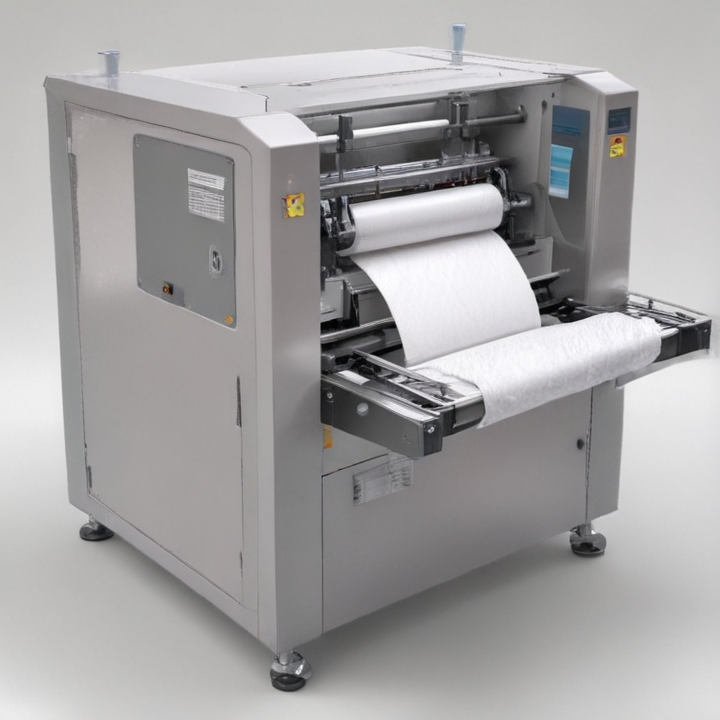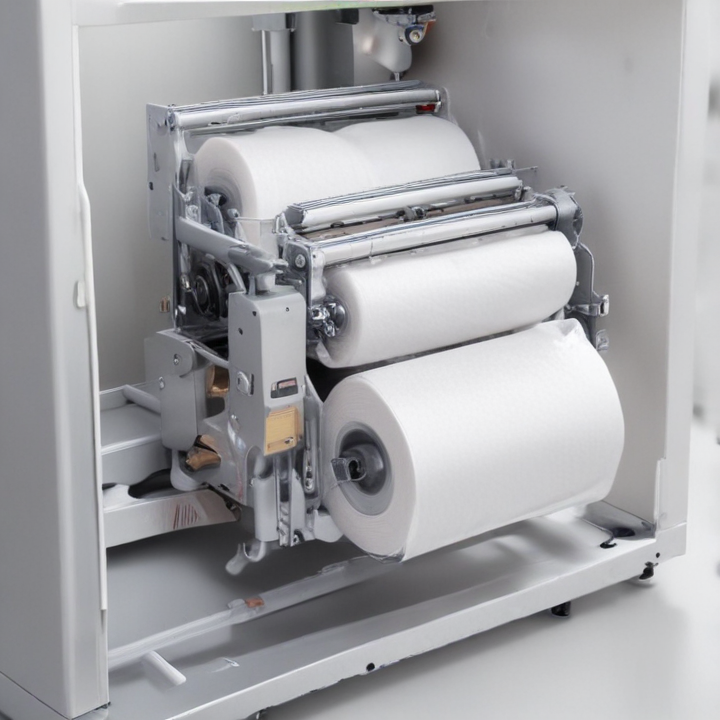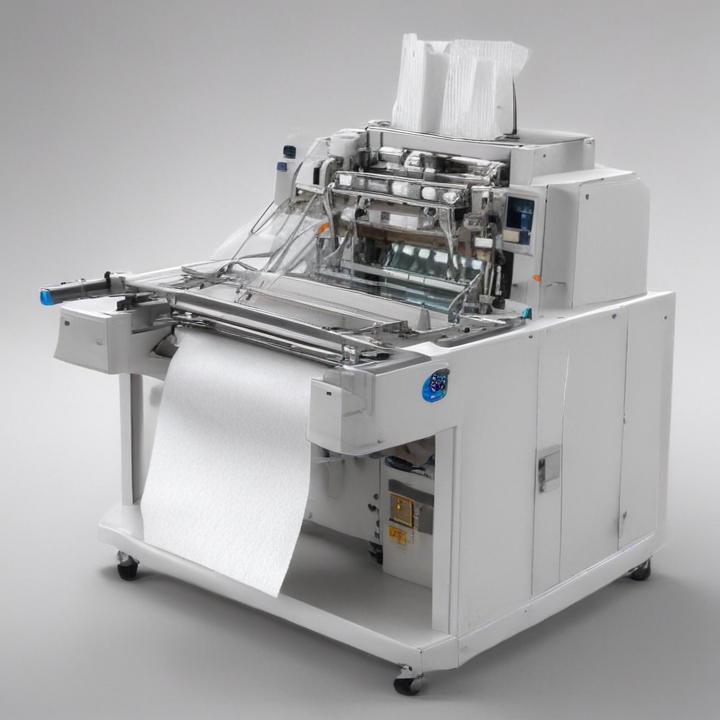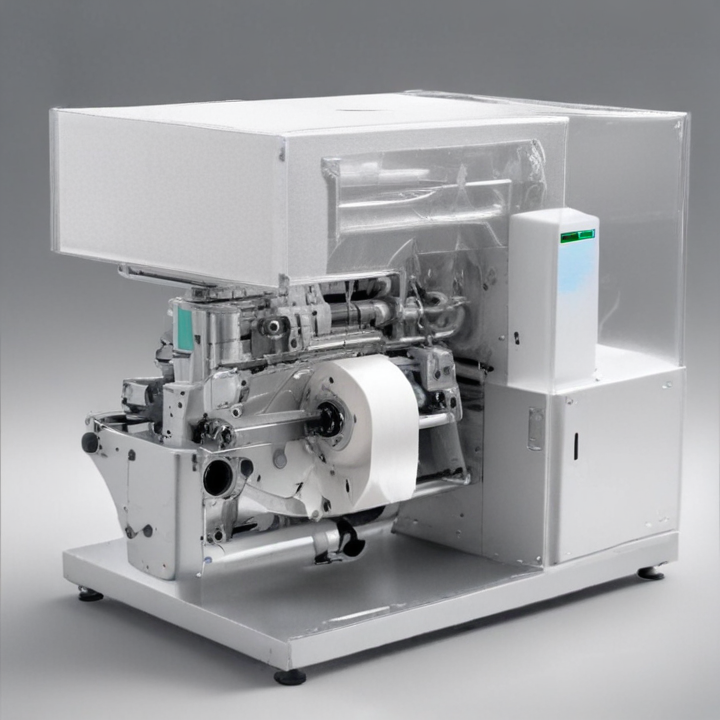List Technical Parameters of “tissue packaging machine”
Tissue packaging machines are sophisticated devices designed to automate the packaging of tissues. These machines ensure that tissues are hygienically packed and presented in a user-friendly manner. Here are the key technical parameters:
1. **Production Speed**:
– **Output Rate**: Typically measured in packs per minute (ppm). Rates can range from 30 ppm to over 200 ppm, depending on the model and application.
2. **Machine Dimensions**:
– **Length, Width, Height**: These can vary but typically are in the range of 3-5 meters in length, 1-2 meters in width, and 2-3 meters in height.
– **Weight**: Machines can weigh from a few hundred kilograms to several tons.
3. **Power Requirements**:
– **Electrical Power**: Standard machines operate on 220-380V, 50/60Hz power supplies with consumption varying between 5 to 20 kW.
4. **Material Compatibility**:
– **Film Type**: Compatible with various wrapping films like polyethylene (PE), polypropylene (PP), and biaxially oriented polypropylene (BOPP).
– **Film Thickness**: Usually selectable between 25 to 50 microns.
5. **Pack Dimensions**:
– **Width, Length, Height**: Adjustable to accommodate different pack sizes, typically ranging from 100-300mm (Width), 200-500mm (Length), and 30-150mm (Height).
6. **Control System**:
– **Interface**: Includes PLC (Programmable Logic Controller) systems with HMI (Human-Machine Interface) touchscreens for user-friendly operation.
– **Connectivity**: Capabilities for integration into automated production lines and remote diagnostics.
7. **Mechanical Features**:
– **Cutting Mechanism**: Rotary or reciprocating blades with adjustable speed and precision.
– **Folding Mechanism**: Various types of folders for different folds like Z-fold, C-fold, etc.
8. **Safety Features**:
– **Guards and Safety Enclosures**: To protect operators.
– **Emergency Stop Buttons**: Strategically placed around the machine.
9. **Maintenance and Compliance**:
– **Easy Access**: Design facilitating maintenance and cleaning.
– **Compliance**: Must adhere to hygiene and safety standards like CE, ISO, or GMP certifications.
10. **Additional Features**:
– **Automatic Roll Change**: Ensures continuous operation.
– **Sealing Technology**: Heat sealing or ultrasonic sealing options.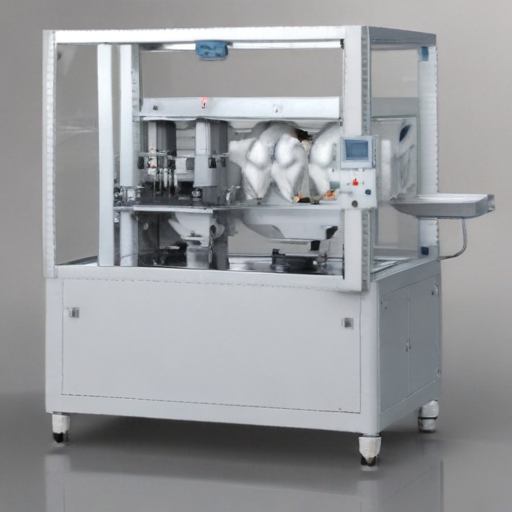
List Product features of “tissue packaging machine”
A tissue packaging machine offers a variety of features to ensure efficient, high-quality, and reliable packaging solutions for tissues. Key features include:
1. **High-Speed Operation**: Capable of packaging tissues at a rapid pace, increasing productivity and reducing manual labor.
2. **Automatic Feeding System**: Ensures continuous and consistent feeding of tissue products into the machine, minimizing downtime.
3. **Versatility**: Suitable for different types of tissues, including facial tissues, toilet paper, and paper towels.
4. **Adjustable Settings**: Allows for easy adjustments to packaging sizes, ensuring flexibility for various product dimensions.
5. **Precision Cutting and Sealing**: High-precision cutting and sealing mechanisms ensure clean and secure packaging, enhancing product presentation and shelf life.
6. **User-Friendly Interface**: Features touch-screen controls and intuitive interfaces for easy operation and minimal training requirements.
7. **Compact Design**: Space-efficient design suitable for various production environments, making the best use of available space.
8. **Durability**: Constructed with high-quality materials for long-lasting performance and reduced maintenance costs.
9. **Error Detection and Correction**: Automated systems for detecting and correcting errors in real-time, reducing waste and ensuring consistent packaging quality.
10. **Energy Efficiency**: Designed to consume less energy, making it environmentally friendly and cost-effective.
11. **Integration Capabilities**: Can be integrated with other packaging and production line equipment for a seamless production process.
12. **Safety Features**: Equipped with protective covers and safety switches to ensure operator safety and meet industrial safety standards.
13. **Customization Options**: Offers various customization options to cater to specific packaging needs and brand requirements.
14. **Hygienic Operation**: Designed to meet hygiene standards, ensuring that the packaging process is clean and suitable for sanitary products.
These comprehensive features of a tissue packaging machine help manufacturers achieve efficient, high-quality, and cost-effective packaging solutions, ensuring a superior final product for consumers.
List Application of “tissue packaging machine”
A tissue packaging machine is a specialized device used for efficiently packaging various types of tissues, such as facial tissues, toilet rolls, and napkins. Below are some of the key applications of tissue packaging machines:
1. **Facial Tissue Packaging:**
– **Home Use:** Packaging facial tissues for convenient use at home, ensuring they remain sanitary and easy to dispense.
– **Commercial Use:** Used in hotels, offices, and public restrooms to provide a hygienic and accessible solution for users.
2. **Toilet Roll Packaging:**
– **Household Products:** Ensures toilet rolls are securely wrapped, protecting them from contamination and making them easy to store.
– **Bulk Packaging:** For distribution to supermarkets, wholesalers, and large scale consumers.
3. **Napkin Packaging:**
– **Dining Establishments:** For restaurants and cafes, packaging napkins in versatile pack sizes to cater to various customer needs.
– **Retail Sales:** Packaging napkins for retail sale, ensuring they are hygienically sealed and market-ready.
4. **Industrial Applications:**
– **Bulk Pack Production:** Packaging large quantities of tissues for bulk wholesale markets and large institutions such as hospitals and schools.
– **Private Label Manufacturing:** For companies producing tissues under various private labels, ensuring customizable and brand-specific packaging solutions.
5. **Travel and Convenience Packs:**
– **On-the-Go Solutions:** Packaging smaller, travel-sized packs for convenience stores and travel retailers to cater to consumers who need tissues on the move.
– **Promotional Packaging:** Creating special packs for promotional purposes, often used in marketing campaigns and giveaways.
6. **Automated Operations:**
– **Increased Efficiency:** Automation in commercial tissue production lines to minimize human intervention and improve speed and consistency.
– **Reduced Labor Costs:** Streamlining the packaging process to reduce manual labor, thereby cutting operational costs.
In summary, tissue packaging machines are integral in various sectors, enhancing product safety, convenience, and brand presentation. They are employed for household use, commercial applications, bulk production, and travel convenience, showcasing their versatility and efficiency.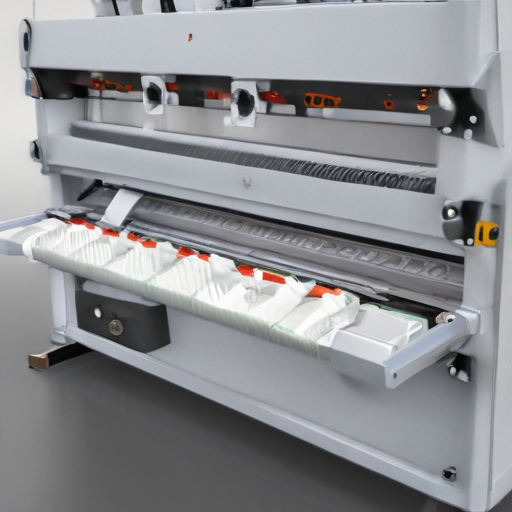
List Various Types of “tissue packaging machine”
Certainly! Tissue packaging machines come in various types, each designed to handle specific packaging needs for different forms of tissue products. Here are some of the main types:
1. **Facial Tissue Packaging Machine**:
– **Box Packing Machines**: These machines wrap facial tissues into cardboard boxes. They can operate at high speeds and often include features for counting and organizing tissues.
– **Soft Pack Machines**: Used for plastic-wrapped facial tissues, these machines create soft packages that are often resealable.
2. **Toilet Tissue Packaging Machine**:
– **Roll Wrappers**: These machines wrap individual or multiple rolls of toilet tissue in plastic or paper for retail sale.
– **Bundling Machines**: Specialized for wrapping multi-packs of toilet tissue rolls, these machines often use shrink wrap or polyethylene film.
3. **Napkin Packaging Machine**:
– **Folded Napkin Wrappers**: Wrap napkins that are folded and stacked, usually in plastic film or paper.
– **Interfolded Napkin Packers**: These machines are specialized for napkins that are interfolded, commonly seen in dispensers.
4. **Kitchen Towel Packaging Machine**:
– **Single Roll Wrappers**: Designed to individually wrap kitchen towel rolls.
– **Multi-Pack Wrappers**: For bundling multiple rolls together, often using shrink wrapping technology.
5. **Hand Towel Packaging Machine**:
– **Z-Fold & C-Fold Packers**: Designed for packing hand towels that are either Z-folded or C-folded, commonly used in public restrooms.
– **Interfolding Machines**: For interfolded hand towels, allowing them to be dispensed one at a time.
6. **Wet Wipes Packaging Machine**:
– **Flow Wrappers**: Used for individually wrapping wet wipes in sachets.
– **Multi-pack Wrappers**: For bundling several wet wipes into plastic pouches or dispensers.
7. **Coreless Tissue Packaging Machine**:
– **Coreless Roll Packers**: These machines wrap coreless tissue rolls, which are more sustainable and offer unique packaging challenges.
Each machine type offers unique features tailored to the specific requirements of the tissue product being packaged, ensuring efficiency, hygiene, and convenience for both manufacturers and consumers.
Custom Manufacturing Options for tissue packaging machine
Custom manufacturing options for a tissue packaging machine are essential for meeting specific industry requirements and enhancing operational efficiency. Key customizable features include:
1. **Size and Capacity**: Tailor the machine to handle different packaging capacities and dimensions, from compact to bulk sizes, ensuring versatility.
2. **Material Compatibility**: Customize the machine to work with various packaging materials like plastic wrap, paper, or biodegradable materials, catering to sustainability goals.
3. **Automation Level**: Choose the level of automation—manual, semi-automatic, or fully automatic—based on productivity needs and budget constraints.
4. **Speed and Throughput**: Adjust the machine’s speed to match production demands, balancing efficiency with quality control.
5. **Cutter and Folders**: Integrate specialized cutters and folders to achieve precise cuts and folds, accommodating diverse packaging styles and designs.
6. **Integration Capabilities**: Ensure the machine is compatible with existing systems like ERP and MES for seamless data flow and production tracking.
7. **User Interface (UI)**: Design the UI for ease of use, incorporating touchscreen controls, multilingual support, and customization options for various operators.
8. **Safety Features**: Incorporate advanced safety mechanisms like emergency stops, safety guards, and sensors to protect operators and ensure compliance with safety regulations.
9. **Energy Efficiency**: Opt for energy-efficient components and systems to reduce operational costs and meet environmental standards.
10. **Maintenance Access**: Design with easy access for maintenance, including modular components that can be quickly replaced to minimize downtime.
11. **Branding and Labeling**: Customize the machine to accommodate different branding and labeling requirements, providing flexibility in packaging design and marketing.
By considering these customizable options, businesses can enhance the functionality, efficiency, and adaptability of their tissue packaging machines, ensuring they meet specific operational and market demands.
List Quality Control and The Manufacturing Process of “tissue packaging machine”
### Quality Control in Tissue Packaging Machine Manufacturing
1. **Material Inspection**: Rigorous checking of raw materials for compliance with specifications.
2. **Machine Calibration**: Precision calibration of equipment to ensure operational accuracy.
3. **Component Testing**: Each component undergoes tests like stress testing and endurance tests.
4. **Assembly Line Monitoring**: Continuous tracking and scrutiny during assembly to detect defects early.
5. **Software Validation**: Verification and validation of any operational software integrated into the machine.
6. **Functional Testing**: Full operational testing to ensure all parts work together seamlessly.
7. **Final Inspection**: Detailed inspection for overall quality, ensuring no defects in the finished product.
8. **Packaging and Shipping Inspection**: Quality checks before shipping to ensure the machine withstands transport without damage.
### Manufacturing Process of Tissue Packaging Machine
1. **Design and Development**:
– **Requirement Analysis**: Determining specifications and requirements.
– **CAD Design**: Creating detailed design using CAD software.
– **Prototype Development**: Building prototypes for preliminary testing and adjustments.
2. **Procurement of Materials and Components**:
– **Vendor Selection**: Choosing suppliers based on quality and reliability.
– **Material Acquisition**: Procuring metals, electronics, and specialized materials.
3. **Fabrication and Manufacturing**:
– **Component Manufacturing**: Producing machine parts through processes like cutting, welding, and molding.
– **Sub-Assembly Construction**: Assembling major sub-components like motors and conveyors.
4. **Main Assembly**:
– **Integration of Sub-Assemblies**: Combining all sub-assemblies into the main machine frame.
– **Installation of Electronics**: Fitting control systems, sensors, and software installations.
5. **Inspection and Testing**:
– **Operational Testing**: Running the machine to ensure functionality and performance.
– **Calibration and Adjustment**: Fine-tuning and calibrating for optimal performance.
6. **Finishing and Quality Assurance**:
– **Final Inspection**: Conducting rigorous final quality checks.
– **Documentation**: Providing manuals and compliance certificates.
– **Packaging**: Secure packaging to protect the machine during shipping.
7. **Shipping and Delivery**:
– **Logistics Planning**: Coordinating the delivery process.
– **Customer Receiving and Setup**: Ensuring safe arrival and assisting with initial setup if required.
This streamlined approach ensures high-quality, reliable tissue packaging machines ready for diverse industrial applications.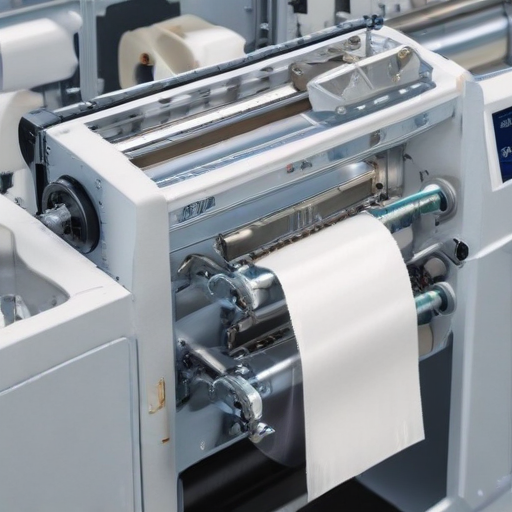
How to use “tissue packaging machine”
Using a tissue packaging machine efficiently involves several key steps. Here’s a concise guide:
1. **Preparation**:
– **Follow Instructions**: Read the machine’s manual thoroughly to understand its specific functions and safety mechanisms.
– **Check Supplies**: Ensure you have adequate tissue rolls or stacks, packaging film, and other necessary materials.
2. **Setup**:
– **Power On**: Switch on the machine and conduct preliminary system checks.
– **Load Material**: Place tissue rolls or stacks on the input feeder or designated platform. Adjust the settings according to the tissue size and type.
– **Install Packaging Material**: Load the packaging film or bags into the machine. This may involve threading the film through designated rollers and guides.
3. **Configuration**:
– **Adjust Settings**: Configure the machine’s parameters such as packaging size, sealing temperature, and speed, based on the tissue size and packaging material.
– **Calibration**: If required, calibrate the machine to ensure precise operation.
4. **Operation**:
– **Start Process**: Initiate the automatic packaging process. The machine will typically feed, wrap, seal, and cut the packages.
– **Monitor**: Continuously monitor the process to ensure proper functioning. Watch for jams, misalignments, or any operational issues.
5. **Post-Operation**:
– **Power Down**: Turn off the machine once the packaging task is completed.
– **Maintenance**: Clean the machine after use to prevent buildup of debris and ensure longevity. Regular maintenance, as per the manufacturer’s guidelines, will ensure optimal performance.
6. **Safety**:
– **Precautions**: Always follow safety protocols, such as using guards and not bypassing safety switches. Wear appropriate personal protective equipment (PPE).
By adhering to these steps, you can efficiently use a tissue packaging machine, maintaining both productivity and safety.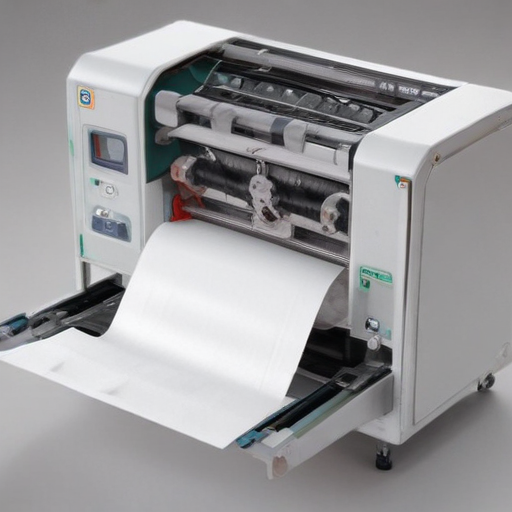
List Properties and Terms of “tissue packaging machine”
Certainly! A “tissue packaging machine” is a specialized piece of equipment used for packaging tissue paper products such as facial tissues, toilet paper, and paper towels. Below are its key properties and terms:
### Properties:
1. **Automation Level**:
– **Manual**: Requires human intervention for various operations.
– **Semi-Automatic**: Partially automated, with some manual input.
– **Fully Automatic**: Automated throughout the packaging process.
2. **Speed and Efficiency**:
– Determines how quickly tissues can be packaged, usually measured in packages per minute (PPM).
3. **Quality Control**:
– Ensures consistent quality of packaging, including error detection and correction mechanisms.
4. **Flexibility**:
– Ability to handle various tissue sizes, formats, and packaging types.
5. **Durability and Build Quality**:
– Made of robust materials like stainless steel to ensure longevity and resistance to wear and tear.
6. **Ease of Maintenance**:
– Feature easy-to-access components for cleaning and repairs.
### Terms:
1. **Cutting Mechanism**:
– The system used to cut tissue paper to desired sizes.
2. **Folding Mechanism**:
– The process of folding tissue paper in a specified pattern before packaging.
3. **Conveyor System**:
– Transports tissue paper through various stages of the packaging process.
4. **Wrapper/Wrapper Film**:
– Material used to encase the tissue product, often in plastic or paper wrappers.
5. **Sealing Mechanism**:
– Heat or adhesive sealing used to secure the wrapper around the tissue.
6. **Stacking**:
– Arrangement of tissue paper into stacks before the wrapping stage.
7. **Palletizing**:
– Organizing packaged tissue products onto pallets for easy transportation.
8. **Inline Printing**:
– Integrated printing system that allows for branding and labeling directly on the packaging material.
9. **Operator Interface (HMI)**:
– Human-Machine Interface through which operators control and monitor the machine’s functions.
10. **Safety Features**:
– Includes emergency stop buttons, safety guards, and other measures to ensure operator safety.
These properties and terms are essential for understanding the functionality, efficiency, and versatility of tissue packaging machines in industrial settings.
List The Evolution history of “tissue packaging machine”
The evolution of tissue packaging machines is a snapshot of broader industrial advancements in automation, precision, and consumer convenience over time.
**Early 20th Century: Manual and Semi-Automatic Packaging**
– Tissue paper became more common in households, initially sold in boxes or as individual sheets.
– Early packaging was largely manual, with workers folding and placing tissues into simple cartons or wrappers.
**Mid 20th Century: Mechanization**
– Post-World War II industrial boom saw the introduction of semi-automatic machines.
– These machines partially automated the folding, cutting, and packaging processes, making them faster and more consistent.
**1970s-1980s: Fully Automatic Machines**
– Electronics and improved mechanical design facilitated fully automatic tissue packaging systems.
– Machines could now perform multiple functions including cutting, folding, stacking, and wrapping with minimal human intervention.
– Introduction of programmable logic controllers (PLCs) enhanced machine functionality and efficiency.
**1990s: Integration and Innovation**
– Development of integrated systems that combined tissue production and packaging into continuous lines.
– Focus on improving hygiene standards led to the creation of cleaner room environments and safer, more sanitary packaging materials.
**2000s: Advanced Automation and Customization**
– Use of robotics and advanced sensors allowed for real-time monitoring and adjustments.
– Customization options increased, enabling packaging of a variety of tissue sizes and formats (e.g., travel packs, jumbo rolls).
– Introduction of eco-friendly materials and sustainability-focused designs.
**2010s-Present: Industry 4.0 and Digitalization**
– Introduction of Industry 4.0 technologies like the Internet of Things (IoT), cloud computing, and artificial intelligence.
– Enhanced data analytics provide insights for preventive maintenance and optimization.
– Convergence of digital twin technologies for virtual modeling and testing of packaging processes prior to implementation.
– Continued innovation in sustainable packaging solutions, integrating biodegradable and recyclable materials.
The evolution of tissue packaging machines reflects a broader trend toward greater efficiency, automation, and sustainability in manufacturing processes.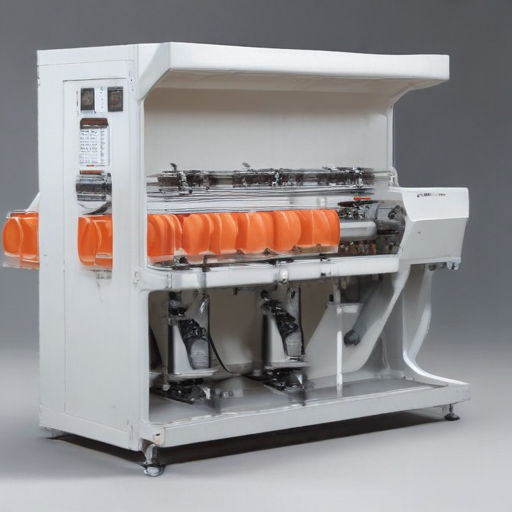
How to Select a Reliable tissue packaging machine
Selecting a reliable tissue packaging machine is crucial for ensuring efficiency, quality, and operational success. Here are key factors to consider:
1. **Reputation and Reviews**:
– Choose manufacturers with a strong market presence and positive customer reviews. Check industry forums and request testimonials.
2. **Machine Specifications**:
– Ensure the machine meets your specific needs (e.g., speed, capacity, type of tissue products). Verify dimensions, power requirements, and packaging capabilities.
3. **Quality and Durability**:
– Prioritize machines made from high-quality materials. Look for robust design and construction.
– Check for certifications and compliance with industry standards.
4. **Technology and Features**:
– Opt for machines with the latest technology for improved efficiency and automation (e.g., touch screens, automated adjustments).
– Consider additional features like error detection, easy maintenance, and flexibility for different packaging styles.
5. **Ease of Operation**:
– Ensure the machine is user-friendly and easy to operate. Training and support should be readily available.
6. **Maintenance and Support**:
– Check the availability of spare parts and the manufacturer’s support network. Reliable after-sales service is essential for minimal downtime.
7. **Cost and ROI**:
– Evaluate the cost versus benefits. Sometimes a higher initial investment yields better long-term savings through reduced maintenance and higher efficiency.
8. **Trial and Demos**:
– Request a trial or demo to see the machine in action. Real-world performance checking is invaluable.
9. **Customization Options**:
– Depending on your specific needs, customization might be important. Ensure the manufacturer can modify the machine to fit your requirements.
10. **Energy Efficiency**:
– Consider energy-efficient models to reduce operational costs and environmental impact.
By thoroughly evaluating these factors, you can make an informed decision and choose a reliable tissue packaging machine that aligns with your business goals.
List “tissue packaging machine” FAQ
**Tissue Packaging Machine FAQ**
1. **What is a tissue packaging machine?**
A tissue packaging machine is specialized equipment designed for wrapping, packing, and sealing tissue products such as facial tissues, toilet paper, and paper towels.
2. **What types of tissue packaging machines are available?**
Various types include automatic, semi-automatic, and manual machines. They can also be categorized by the type of product they package, such as facial tissue packaging machines, toilet paper packaging machines, and paper towel packaging machines.
3. **How does a tissue packaging machine work?**
Typically, these machines automate the process of feeding, cutting, folding, wrapping, and sealing tissue products. Specific operations can vary depending on the machine’s design and purpose.
4. **What are the key features to consider when choosing a tissue packaging machine?**
Important features include packaging speed, product compatibility, automation level, ease of operation and maintenance, machine footprint, and integration with other production line equipment.
5. **What are the benefits of using an automatic tissue packaging machine?**
Automatic machines increase production efficiency, improve packaging consistency, reduce labor costs, and minimize human error. They also handle large volumes of products more effectively.
6. **What maintenance is required for a tissue packaging machine?**
Regular maintenance involves cleaning, lubricating moving parts, checking for wear and tear, replacing worn-out components, and ensuring all sensors and controls are functioning properly.
7. **Can tissue packaging machines handle multiple packaging formats?**
Many modern tissue packaging machines are versatile and can handle various packaging styles, such as flat boxes, soft packs, rolls, and bundles, often through adjustable settings or interchangeable parts.
8. **What are common issues encountered with tissue packaging machines?**
Typical problems include jams, misfeeds, inconsistent packaging, mechanical wear, and control system errors. Routine maintenance and proper training can mitigate most of these issues.
9. **Is training required to operate a tissue packaging machine?**
Yes, adequate training is essential to ensure safe and efficient operation, troubleshoot common problems, and perform maintenance.
10. **How much do tissue packaging machines cost?**
Prices vary depending on machine type, features, and capacity. It can range from a few thousand to several hundred thousand dollars.
This concise FAQ provides a foundational understanding for anyone considering investing in a tissue packaging machine.
Top 10 FAQ with answer about tissue packaging machine for Buyer Sourcing from China
Certainly! Here are the top 10 frequently asked questions (FAQ) about sourcing tissue packaging machines from China, along with concise answers:
1. **What types of tissue packaging machines are available?**
China offers a variety of tissue packaging machines including facial tissue machines, toilet paper machines, napkin machines, and hand towel machines.
2. **What is the lead time for delivery?**
The lead time varies depending on the machine’s complexity and manufacturer’s schedule, typically ranging from 30 to 90 days.
3. **Can I get customization on the machines?**
Yes, most Chinese manufacturers offer customization options based on specific requirements such as size, capacity, and additional features.
4. **What is the cost range for these machines?**
Prices can range from $10,000 to $100,000 or more depending on the machine type, specifications, and features.
5. **How is the warranty and after-sales service?**
Most manufacturers provide a 1-year warranty and offer after-sales services like installation support, training, and spare parts.
6. **Are the machines compliant with international standards?**
Many Chinese manufacturers are ISO certified and can adhere to other international standards, but it’s crucial to verify compliance for specific markets.
7. **How can I verify the credibility of the supplier?**
Conduct thorough research, request references, read reviews, and consider third-party audits or site visits to verify supplier credibility.
8. **What payment terms are generally accepted?**
Common payment terms include T/T (Telegraphic Transfer), L/C (Letter of Credit), and sometimes flexible terms such as deposits and balance payments upon shipment.
9. **Is technical support available post-purchase?**
Yes, manufacturers usually provide ongoing technical support and can assist remotely or through local service partners.
10. **Are there any hidden costs to be aware of?**
Be sure to inquire about any additional costs such as shipping, customs duties, installation fees, and maintenance costs to avoid surprises.
These answers should help you get a clearer understanding of what to expect and consider when sourcing tissue packaging machines from China.

